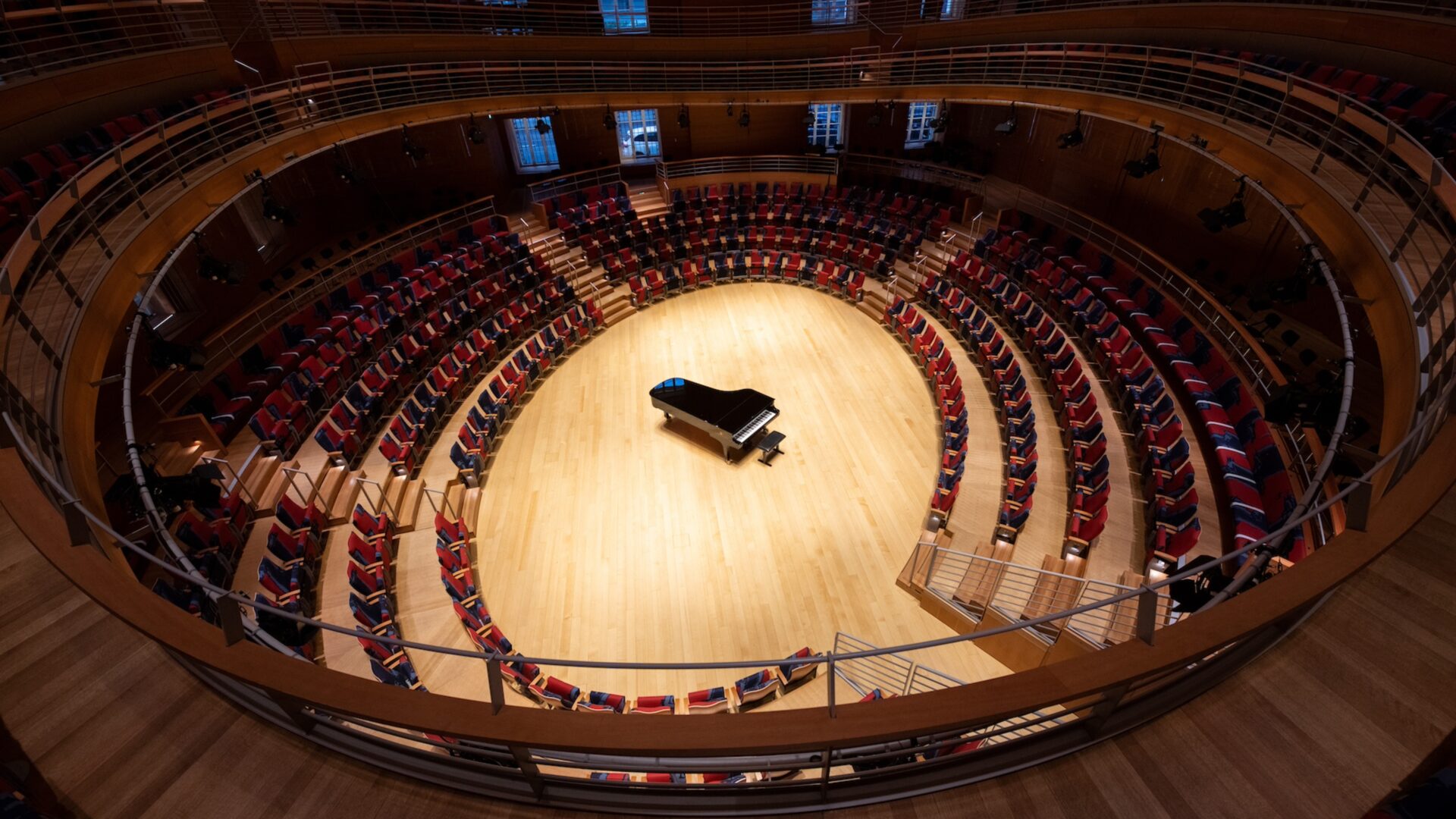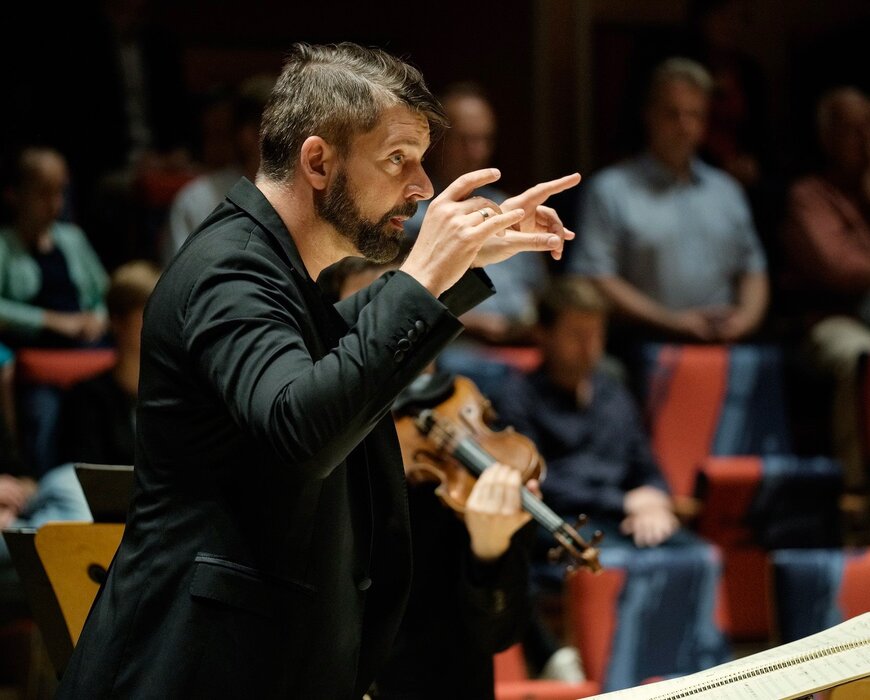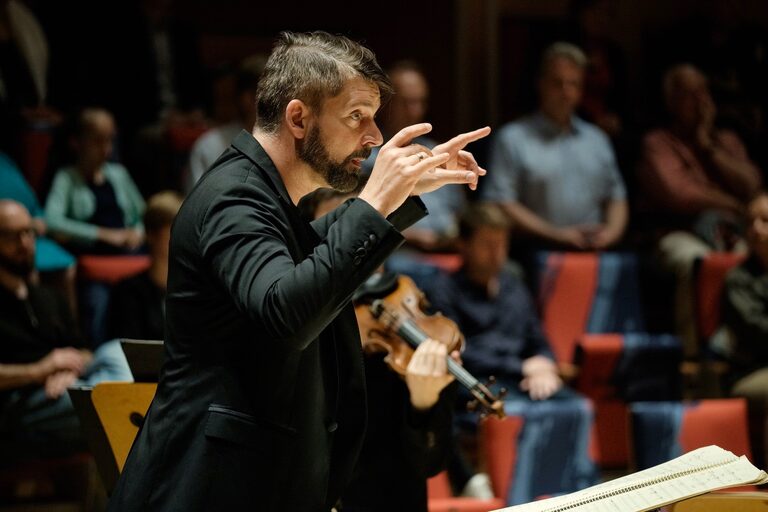Sat, December 2, 2023 at 7:00 PM
BOULEZ ENSEMBLE & MATTHIAS PINTSCHER
Lichtspielszenen: Mozart, Schoenberg, Ligeti, Chin
Pierre Boulez Saal
The Old High German word gougalon is the origin of the modern verb gaukeln, which describes the performance of medieval street entertainers. In her eponymous ensemble piece, Unsuk Chin employs contemporary musical means to imagine “Scenes from a Street Theater,” inspired by a blend of hypermodern urbanity and the labyrinthine, history-rich alleyways of 1960’s Seoul during the composer’s childhood. Matthias Pintscher and the Boulez Ensemble combine Chin’s “imaginary folk music” with Schoenberg’s “accompaniment” to an equally imaginary film scene and the suggestive polyrhythms of Ligeti’s Piano Concerto, featuring Barenboim-Said Akademie alumna Julia Hamos as the soloist. Mozart’s C-minor Serenade opens the program.
Artists
Conductor
Piano
Flute
Oboe
Oboe
Clarinet
Clarinet
Bassoon
Bassoon
French Horn
French Horn
Trumpet
Trumpet
Trombone
Percussion
Percussion
Percussion
Piano
piano
Violin
Violin
Viola
Violoncello
Violoncello
Double Bass
Program
Pushing the Boundaries A Conversation with Julia Hamos
You’re making your solo debut at the Pierre Boulez Saal with Ligeti's Piano Concerto, which is notorious for its extremely virtuoso piano part…
It’s a challenge to play, and can also be challenging to listen to, but in a live performance it becomes very, very exciting. Musically speaking, it’s a masterpiece that draws on African rhythms and Hungarian folk songs. A lot of it is written with the piano and the orchestra in different meters—for example, the conductor might beat in four but you’re playing in six, and when the music is fast and loud, this can throw you off. There are often different key signatures for the right and left hand, and you also need a lot of rhythmic coordination between the two hands. So you have those three elements creating a challenge. I played the piece for the first time last year with a big orchestra, where most parts are doubled or tripled, but I actually think it works better in the ensemble version we’re doing at the Pierre Boulez Saal, because you can hear the individual lines more clearly, including the piano.
You’re making your solo debut at the Pierre Boulez Saal with Ligeti's Piano Concerto, which is notorious for its extremely virtuoso piano part…
It’s a challenge to play, and can also be challenging to listen to, but in a live performance it becomes very, very exciting. Musically speaking, it’s a masterpiece that draws on African rhythms and Hungarian folk songs. A lot of it is written with the piano and the orchestra in different meters—for example, the conductor might beat in four but you’re playing in six, and when the music is fast and loud, this can throw you off. There are often different key signatures for the right and left hand, and you also need a lot of rhythmic coordination between the two hands. So you have those three elements creating a challenge. I played the piece for the first time last year with a big orchestra, where most parts are doubled or tripled, but I actually think it works better in the ensemble version we’re doing at the Pierre Boulez Saal, because you can hear the individual lines more clearly, including the piano.
Has your view of the piece changed since that earlier performance?
I think so. First of all, going back to a score is always different than learning it. It took me about a year to learn the notes. Now it’s more about getting it under your skin—the rhythms, the way all the parts move and work together, and getting in into your body almost as a part of yourself, rather than just trying to play it. I also believe I have changed, the world has changed. There’s more of a need for something immediate or urgent—like the music of Ligeti. It’s not what you would call “beautiful,” this isn’t music that calms you, it’s the kind of music that wakes you up. So as a listener as well you can be more attentive and present. I think in many ways this time we’re living in is waking us all up. Psychologically, this is something I’m drawn toward.
You grew up in the U.S. but your family background is Hungarian. How did that influence your approach to Ligeti’s music?
Ligeti and my grandfather both grew up in Transylvania around the same time. Ligeti was older, but they went to the same high school. I think it's very likely they met, although unfortunately my grandfather passed away three years ago, so I couldn’t ask him. They were both from the same place and the same culture. My grandfather was Jewish as well, so they suffered from similar experiences. The way I grew up and was taught, especially by my grandfather, who was also an artist, a photographer, was very much about what it means to work, to create something, to strive for excellence without ever being satisfied. I think there’s an element of this in Ligeti’s music—this constant pushing of boundaries. Hungarian culture has influenced me a lot, particularly Transylvanian culture, which I think is what Ligeti is about. I speak Hungarian, and I can recognize the Hungarian folk songs he uses. They’re subtly woven into the music. The opening melody of the third movement for example sounds like the sirató, which is a type of funeral song. Bartók also uses it a lot, and Kurtág as well.
Other than playing Ligeti, what are you most excited for about this concert?
I’ve never worked with Matthias Pintscher, so I’m really looking forward to that. And I love being part of the Boulez Ensemble because it’s so innovative and multi-generational. It feels like a place where you can go to experiment, be free and open, make mistakes, and fix mistakes. It’s wonderful we’re performing here at the Barenboim-Said Akademie, where I went to school.
What were some of your most memorable experiences studying here?
This place is very special and so relevant to the current climate we’re living in. It’s amazing this building exists. I think the Academy, and András Schiff specifically, have prepared me for the real world—musically, but not only that. There are so many things that I understood from studying with him, I’m forever grateful for that. One of the things he told us is to play as if your life depended on it, but at the same time not to take yourself too seriously. He taught me a lot about balance, about taste and musical value, how to listen, how to approach music you’ve never played before. We all did a lot of student concerts in the Mozart Auditorium, which was helpful for me because I have stage fright. This experience pushed me beyond my limits, and I believe he was very much aware of that. I’m very grateful for these opportunities. I also owe a lot to Schaghajegh Nosrati, Mr. Schiff’s assistant, and to Michael Wendeberg, who helped me learn the Ligeti Concerto when I first played it.
You perform quite a bit of different repertoire, from the Baroque to the present, and you’ve also collaborated with several dance and theater companies. What inspires you to branch out in new directions?
I come from a family of people who aren’t musicians but who are moved by various art forms. Growing up, I always went to see ballets, plays, concerts, operas… Many people in my family are into visual arts or architecture. My mother is an engineer, she actually worked with Frank Gehry. So there’s always this element of understanding how something is built, what makes it stand, what’s behind it, and what its foundations are. This perspective also drives me toward new repertoire—if I recognize that the foundations of a piece are great, I try to play it or find a way to do so. I think as musicians we do so much music that sometimes it’s very good to seek inspiration elsewhere. That doesn’t mean you don’t need to look at the score. In fact, when I do that I often try to make a story out of it, try to understand how one part leads to the next. I analyze it in my own way, not necessarily in the traditional sense, but it makes me feel more involved in the piece. One of the things that truly fascinate me is to understand how something is put together, how it’s held together and given shape. How does it come to life? And then in the rehearsal or the performance there’s an added human element that makes a piece of music truly great. I think you can sense when it’s not just calculated but imagined and thought through.
Interview: Wioleta Zochowska
watch
YOUR VISIT
How To Get There
Pierre Boulez Saal
Barenboim-Said Akademie
Französische Straße 33d
10117 Berlin
_____
Public Transport
U-Bahn U2 Hausvogteiplatz, U5 Museumsinsel, U6 Unter den Linden
S-Bahn S / U Friedrichstraße
Tram M1, 12 Mitte / Am Kupfergraben
Bus 147 Werderscher Markt; 100, 300, N5 Staatsoper
Bicycle
Bicycle racks are available on the street “Hinter der Katholischen Kirche.”
Car
Q-PARK parking garage Unter den Linden / Staatsoper
Bebelplatz 2
10117 Berlin
Theater rate (5.30 pm – 11.30 pm, paid in advance): €10
Please note there is a construction site across from the hall on Französische Straße. The street is narrowed, and cars or taxis are not allowed to stop in front of the Pierre Boulez Saal entrance.
Opening Hours
Box Office
Monday to Friday 2 pm to 6 pm
Closed on weekends and holidays
On performance days, the box office opens one hour prior to an event on weekdays and two hours on Saturdays, Sundays, and holidays.
Papagena Call Center
Ticket hotline +49 30 4799 7411
Monday to Saturday 9am to 8pm
Sunday and public holidays 2pm to 8pm
Food & Drinks
Casalot Catering welcomes Pierre Boulez Saal visitors before and after concerts, serving a variety of dishes of Arab cuisine.
On concert nights, the bar opens one hour before the start of an event and remains open after the performance. You may also place pre-orders for intermission right at the counter.
More informantion on our catering can be found here.
Coat Check
Small bags up to a maximum size of A4 (21x30 cm) and jackets may be taken into the concert hall. Luggage, helmets, large umbrellas, and other bulky items must be stored at the coat check.
The coat check is free and located behind the staircase in the foyer, on the left-hand side.
Accessibility
To book wheelchair-accessible seating, other seats for visitors with disabilities, or companion seats, please contact us directly.
+49 30 4799 7411
tickets@boulezsaal.de
All wheelchair seats are accessible by elevator. All visitors, including patrons using a wheelchair, will enter the Pierre Boulez Saal through the main entrance. Tickets will be checked at the hall doors.
In order to make access as easy as possible, we kindly ask that you inform us of your requirements when booking your tickets.
Restrooms for visitors with disabilities are located in the basement and on the balcony level and are accessible by elevator.
Four parking spaces for visitors with disabilities are available on the street Hinter der Katholischen Kirche.


